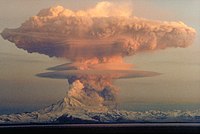
Photo from wikipedia
Two-dimensional numerical simulations of a rotating detonation combustor (RDC) fueled by ethylene–oxygen–nitrogen were performed to investigate the evolution process of multiple rotating detonation waves (RDWs), that is, initial chaotic stage,… Click to show full abstract
Two-dimensional numerical simulations of a rotating detonation combustor (RDC) fueled by ethylene–oxygen–nitrogen were performed to investigate the evolution process of multiple rotating detonation waves (RDWs), that is, initial chaotic stage, self-adjustment stage, and the final stable stage. The number of stable RDWs corresponding to the initial conditions was in good agreement with that predicted by an empirical model proposed by Daniau et al. from Lavrenty’ev Institute of Hydrodynamics (LIH). From the simulation results, the spontaneous formation of a reverse RDW and the transition of trailing waves to detonation waves contribute to the emergence of the chaotic stage. The self-adjustment stage comprises three distinctive parts, which are the self-adjustment of the propagation direction, the number, and the propagation characteristics of RDWs. Furthermore, the double-wave collision was found to play a significant role in modulating the propagation direction as well as the number of RDWs. The same self-adjusting trend of different instantaneous propagation characteristics (e.g., peak pressure, propagation velocity, and wave front height) of the RDWs was observed, suggesting the self-similarity property of the adjusting mechanism demonstrated in the evolution of rotating detonation dynamics.
Journal Title: Proceedings of the Institution of Mechanical Engineers, Part G: Journal of Aerospace Engineering
Year Published: 2021
Link to full text (if available)
Share on Social Media: Sign Up to like & get
recommendations!